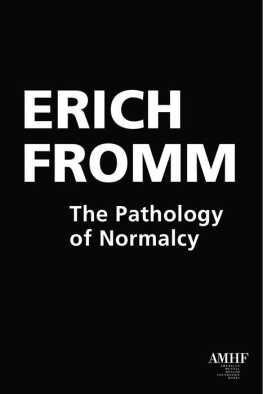
The Anatomy of Human Destructiveness
Erich Fromm

Preface
THIS STUDY IS THE first volume of a comprehensive work on psychoanalytic theory. I started with the study of aggression and destructiveness because, aside from being one of the fundamental theoretical problems in psychoanalysis, the wave of destructiveness engulfing the world makes it also one of the most practically relevant ones.
When I started this book over six years ago I greatly underestimated the difficulties I would encounter. It soon became apparent that I could not write adequately about human destructiveness if I remained within the limits of my main field of competence, that of psychoanalysis. While this investigation is primarily meant to be a psychoanalytic one, I also needed a modicum of knowledge in other fields, particularly neurophysiology, animal psychology, paleontology, and anthropology, in order to avoid working in too narrow and, hence, a distorting frame of reference. At least I had to be able to check my conclusions with the main data from other fields to make certain that my hypotheses did not contradict them and to determine whether, as was my hope, they confirmed my hypothesis.
Since no work existed that reports and integrates the findings on aggression in all these fields, or even summarizes them in any one specific field, I had to make such an attempt myself. This attempt, I thought, would also serve my readers by offering them the possibility of sharing with me the global view of the problem of destructiveness rather than a view taken from the standpoint of a single discipline. There are, it is clear, many pitfalls in such an attempt. Obviously, I could not acquire competence in all these fieldsleast of all, the one in which I started out with little knowledge: the neurosciences. I was able to gain a modicum of knowledge in this field not only by studying it myself but also through the kindness of neuroscientists, a number of whom gave me guidance and answered my many questions and some of whom read the relevant part of the manuscript. Although specialists will realize that I have nothing new to offer them in their particular fields, they may also welcome the opportunity of a better acquaintance with data from other areas on a subject of such central importance.
An insoluble problem is that of repetitions and overlapping from my previous work. I have been working on the problems of man for more than thirty years and, in the process, focusing on new areas while deepening and widening my insights in older ones. I cannot possibly write about human destructiveness without presenting ideas that I have of the new concepts with which this book deals. I have tried to hold down repetition as much as possiblereferring to the more extensive discussion in previous publications; but repetitions were nevertheless unavoidable. A special problem in this respect is The Heart of Man, which contains some of my new findings on necrophilia-biophilia in a nuclear form. My presentation of these findings is greatly expanded in the present book, both theoretically and with regard to clinical illustration. I did not discuss certain differences between the views expressed here and in previous writings, since such a discussion would have taken a great deal of space and is not of sufficient interest for most readers.
There remains only the pleasant task of expressing my thanks to those who helped me in the writing of this book.
I want to thank Dr. Jerome Brams, to whom I am much indebted for his helpfulness in the theoretical clarification of problems of behaviorism and for his never tiring assistance in the search for relevant literature.
I am gratefully indebted to Dr. Juan de Dios Hernndez for his help in facilitating my study of neurophysiology. He clarified many problems through hours of discussion, oriented me in the vast literature, and commented on those parts of the manuscript dealing with the problems of neurophysiology.
I am thankful to the following neuroscientists who helped me by sometimes extended personal conversations and letters: the late Dr. Raul Hernndez Pen, Drs. Robert B. Livingston, Robert G. Heath, Heinz von Foerster, and Theodore Melnechuk who also read the neurophysiological sections of the manuscript. I am also indebted to Dr. Francis O. Schmitt for arranging a meeting for me with members of the Neurosciences Research Program, Massachusetts Institute of Technology, at which members discussed questions that I addressed to them. I thank Albert Speer, who in conversation and correspondence, was most helpful in enriching my picture of Hitler. I am indebted also to Robert M. W. Kempner for information he had collected as one of the American prosecutors in the Nrnberg trials.
I am also thankful to Dr. David Schecter, Dr. Michael Maccoby, and Gertrud Hunziker-Fromm for their reading of the manuscript and for their valuable critical and constructive suggestions; to Dr. Ivan Illich and Dr. Ramon Xirau for their helpful suggestions in philosophical matters; to Dr. W. A. Mason for his comments in the field of animal psychology; to Dr. Helmuth de Terra for his helpful comments on problems of paleontology; to Max Hunziker for his helpful suggestions in reference to surrealism, and to Heinz Brandt for his clarifying information and suggestions on the practices of Nazi terror. I am thankful to Dr. Kalinkowitz for the active and encouraging interest he showed in this work. I also thank Dr. Illich and Miss Valentina Boresman for their assistance in the use of the bibliographic facilities of the Center for Intercultural Documentation in Cuernavaca, Mexico.
I want to use this occasion to express my warm gratitude to Mrs. Beatrice H. Mayer, who over the last twenty years has not only typed and retyped the many versions of each manuscript I have written, including the present one, but has also edited them with great sensitivity, understanding, and conscientiousness with respect to language and by making many valuable suggestions.
In the months I was abroad, Mrs. Joan Hughes took care of the manuscript very competently and constructively, which I thankfully acknowledge.
I express my thanks, also to Mr. Joseph Cunneen, senior editor, Holt, Rinehart and Winston, for his very able and conscientious editorial work and his constructive suggestions. I want to thank, furthermore, Mrs. Lorraine Hill, managing editor, and Mr. Wilson R. Gathings and Miss Cathie Fallin, production editors, Holt, Rinehart and Winston, for their skill and care in coordinating the work on the manuscript in its various stages of production. Finally, I thank Marion Odomirok for the excellence of her conscientious and penetrating editing.
This investigation was supported in part by Public Health Service Grant No. MH 13144-01, MH 13144-02, National Institute of Mental Health. I acknowledge a contribution by the Albert and Mary Lasker Foundation that enabled me to obtain additional help by an assistant.
E. F.
New York, May 1973
Terminology
THE EQUIVOCAL USE of the word aggression has created great confusion in the rich literature on this topic. The term has been applied to the behavior of a man defending his life against attack, to a robber killing his victim in order to obtain money, to a sadist torturing a prisoner. The confusion goes even further: the term has been used for the sexual approach of the male to the female, to the forward-driving impulses of a mountain climber or a salesman, and to the peasant ploughing the earth. This confusion is perhaps due to the influence of behaviorist thinking in psychology and psychiatry. If one calls aggression all noxious actsthat is, those that have the effect of damaging or destroying a nonliving thing, a plant, an animal, or a manthen, of course, the quality of the impulse behind the noxious act is entirely irrelevant. If acts that are meant to destroy, acts that are meant to protect, and acts that are meant to construct are all denoted by one and the same word, then indeed there is no hope of understanding their cause; they have no common cause because they are entirely different phenomena, and one is in a theoretically hopeless position if one tries to find the cause of aggression.
Next page


















